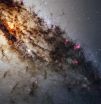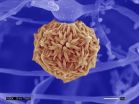(Press-News.org) A bright flash of gamma rays observed March 28 by the Swift satellite may have been the death rattle of a star falling into a massive black hole and being ripped apart, according to a team of astronomers led by the University of California, Berkeley.
When the Swift Gamma Burst Mission spacecraft first detected the flash within the constellation Draco, astronomers thought it was a gamma-ray burst from a collapsing star. On March 31, however, UC Berkeley's Joshua Bloom sent out an email circular suggesting that it wasn't a typical gamma-ray burst at all, but a high-energy jet produced as a star about the size of our sun was shredded by a black hole a million times more massive.
Careful analysis of the Swift data and subsequent observations by the Hubble Space Telescope and the Chandra X-ray Observatory confirmed Bloom's initial insight. The details are published online today (Thursday, June 16) in Science Express, a rapid publication arm of the journal Science.
"This is truly different from any explosive event we have seen before," Bloom said.
What made this gamma-ray flare, called Sw 1644+57, stand out from a typical burst were its long duration and the fact that it appeared to come from the center of a galaxy nearly 4 billion light years away. Since most, if not all, galaxies are thought to contain a massive black hole at the center, a long-duration burst could conceivably come from the relatively slow tidal disruption of an infalling star, the astronomers said.
"This burst produced a tremendous amount of energy over a fairly long period of time, and the event is still going on more than two and a half months later," said Bloom, an associate professor of astronomy at UC Berkeley. "That's because as the black hole rips the star apart, the mass swirls around like water going down a drain, and this swirling process releases a lot of energy."
Bloom and his colleagues propose in their Science Express paper that some 10 percent of the infalling star's mass is turned into energy and irradiated as X-rays from the swirling accretion disk or as X-rays and higher energy gamma rays from a relativistic jet that punches out along the rotation axis. Earth just happened to be in the eye of the gamma-ray beam.
Bloom draws an analogy with a quasar, which is a distant galaxy that emits bright, high-energy light because of the massive black hole at its center gobbling up stars and sending out a jet of X-rays along its rotation axis. Observed from an angle, these bright emissions are called active galactic nuclei, but when observed down the axis of the jet, they're referred to as blazars.
"We argue that this must be jetted material and we're looking down the barrel," he said. "Jetting is a common phenomenon when you have accretion disks, and black holes actually prefer to make jets."
Looking back at previous observations of this region of the cosmos, Bloom and his team could find no evidence of X-ray or gamma-ray emissions, leading them to conclude that this is a "one-off event," Bloom said.
"Here, you have a black hole sitting quiescently, not gobbling up matter, and all of a sudden something sets it off," Bloom said. "This could happen in our own galaxy, where a black hole sits at the center living in quiescence, and occasionally burbles or hiccups as it swallows a little bit of gas. From a distance, it would appear dormant, until a star randomly wanders too close and is shredded."
Probable tidal disruptions of a star by a massive black hole have previously been seen at X-ray, ultraviolet and optical wavelengths, but never before at gamma-ray energies. Such random events, especially looking down the barrel of a jet, are incredibly rare, "probably once in 100 million years in any given galaxy," said Bloom. "I would be surprised if we saw another one of these anywhere in the sky in the next decade."
The astronomers suspect that the gamma-ray emissions began March 24 or 25 in the uncatalogued galaxy at a redshift of 0.3534, putting it at a distance of about 3.8 billion light years. Bloom and his colleagues estimate that the emissions will fade over the next year.
"We think this event was detected around the time it was as bright as it will ever be, and if it's really a star being ripped apart by a massive black hole, we predict that it will never happen again in this galaxy," he said.
###
Bloom's colleagues include UC Berkeley theoretical physicist Elliot Quataert, who models the production of jets from accretion disks, and UC Berkeley astronomers S. Bradley Cenko, Daniel A. Perley, Nathaniel R. Butler, Linda E. Strubbe, Antonino Cucchiara, Geoffrey C. Bower and Adam N. Morgan; Dimitrios Giannios and Brian D. Metzger of Princeton University; Andrew J. Levan of the University of Warwick, Coventry, United Kingdom; Nial R. Tanvir, Paul T. O' Brien, Andrew R. King and Sergei Nayakshin of the University of Leicester in the U.K.; Fabio De Colle, Enrico Ramirez-Ruiz and James Guillochon of UC Santa Cruz; William H. Lee of the Universidad Nacional Autonoma de México in Mexico City; Andrew S. Fruchter of the Space Telescope Science Institute in Baltimore, Md.; and Alexander J. van der Horst of the Universities Space Research Association in Huntsville, Ala.
Levan is first author of the companion Science Express paper, and leader of the Chandra and Hubble Space Telescope observation team.
Bloom and his laboratory are supported by grants from NASA and the National Science Foundation.
Gamma-ray flash came from star being eaten by massive black hole
Unusual, long-duration gamma-ray flare came from center of distant galaxy
2011-06-17
ELSE PRESS RELEASES FROM THIS DATE:
UMD-led EPOXI science team publishes latest comet findings in Science
2011-06-17
COLLEGE PARK, Md. –- Comet Hartley 2, is in a hyperactive class of its own compared to other comets visited by spacecraft, says a University of Maryland-led study published in the June 17 issue of the journal Science.
The comet was visited last fall by NASA's Deep Impact spacecraft during its EPOXI mission. The EPOXI science team's new, in-depth analysis of the images and data taken during the flyby confirms its earlier finding that carbon dioxide is the volatile fuel for Hartley 2's ice-spewing jets.
In-depth analysis of the images and data taken during the flyby ...
Cynthia Hennessey Wins Several Million Dollar Settlements Surrounding Workers' Compensation Laws
2011-06-17
Cynthia Hennessey has recently won several million-dollar settlements from work-related injury cases. With over two decades of workers' compensation experience and six years of experience as a registered nurse, Cynthia brings her compassion and expertise to the niche area of workers' compensation cases.
Before becoming an attorney, Cynthia spent six years as a registered nurse working in both the pediatric and adult intensive care areas. This experience led her to develop a compassion for defending those who have been injured at work and ensuring they receive the medical ...
Black hole kills star and blasts 3.8 billion light year beam at Earth
2011-06-17
Research led by astronomers at the University of Warwick has confirmed that the flash from one of the biggest and brightest bangs yet recorded by astronomers comes from a massive black hole at the centre of a distant galaxy. The black hole appears to have ripped apart a star that wandered too close, creating a powerful beam of energy that crossed the 3.8 billion light years to Earth.
Their research is published today in the Journal Science in a paper entitled "An Extremely Luminous Panchromatic Outburst from the Nucleus of a Distant Galaxy"
The high energy X-rays and ...
Unlock Advantage is an Industry Leader in Providing T-Mobile Unlock Codes, Including for the T-Mobile G2 Android Phone
2011-06-17
A highly rated phone that Unlock Advantage provides T-Mobile unlock codes for is the T-Mobile G2 with Google. Consumers rave about this mobile device, and they have plenty of reasons.
The T-Mobile G2 with Google is T-Mobile's first Android-powered 4G smartphone. This fine-looking device has an excellent QWERTY keyboard and makes it possible to download apps and search the Internet at incredible speeds. The keyboard has three quick keys that are user-customizable and can each be set to launch any app; this is an awesome feature. When this mobile device is closed, there's ...
Searching for the 'perfect glass'
2011-06-17
Washington, D.C.—Glasses differ from crystals. Crystals are organized in repeating patterns that extend in every direction. Glasses lack this strict organization, but do sometimes demonstrate order among neighboring atoms. New research from Carnegie's Geophysical Laboratory reveals the possibility of creating a metallic glass that is organized on a larger scale. Their results are published June 17 in Science.
Scientists have discovered glasses that demonstrate order among the nearest neighboring atoms, called short-range order, and a slightly wider range of atoms, called ...
Spectacular Hubble view of Centaurus A
2011-06-17
Centaurus A, also known as NGC 5128, is well known for its dramatic dusty lanes of dark material. Hubble's observations, using its most advanced instrument, the Wide Field Camera 3, are the most detailed ever made of this galaxy. They have been combined here in a multi-wavelength image that reveals never-before-seen detail in the dusty portion of the galaxy.
As well as features in the visible spectrum, this composite shows ultraviolet light from young stars, and near-infrared light, which lets us glimpse some of the detail otherwise obscured by the dust.
The dark dust ...
Organizing Bedroom Closets is a Common Household Problem that Closets by Design has Been Helping to Solve Since 1982
2011-06-17
Closets by Design provides innovative solutions to the challenge of home organization. Recognizing that unorganized bedroom closets are a problem faced by many, Closets by Design offers not only closet ideas but also tips for problem solving.
Eliminating clutter in the home is sometimes a daunting task. One way to face the challenge is to view the issue as merely a problem to be solved.
There are many ways to approach a problem. The following are a few suggestions that together could help you conquer your bedroom closets.
If your bedroom closets are a disorganized ...
Size matters -- in virulent fungal spores -- and suggests ways to stop a killer
2011-06-17
DURHAM, N.C. – Scientists at Duke University Medical Center have found that larger fungal spores can be more lethal. Their findings about two different spore sizes of the fungus Mucor circinelloides, a pathogen that kills half or more of its victims, could help to develop new treatments and fight other types of fungal infections.
Mucor infection is in the news as an environmental fungus contracted by people who had trauma in the wake of tornadoes in Joplin, Mo. Three out of eight patients had died by June 11. This group of fungi can be common in the environment but only ...
AdaptMy.com Has Vision Tips to Reduce Falls in the Home
2011-06-17
Vision impairment is strongly associated with falls. Two of the vision limitations most commonly associated with falls are reduced visual field and impaired contrast sensitivity.
The majority of falls occur in the bathroom. Grab bars can help you regain your balance and prevent these falls, but aren't helpful if visual impairment prevents you from grasping the bars quickly. That is why Andrea Tannenbaum, president of AdaptMy.com, highly recommends bathroom grab bars with a strong contrasting color to the walls.
High contrast colors are much easier to see for people ...
Barrett's esophagus carries lower risk of malignancy than previously reported
2011-06-17
Patients with Barrett's esophagus may have a lower risk of esophageal cancer than previously reported, according to a large, long-term study published online June 16 in the Journal of the National Cancer Institute.
Barrett's esophagus is a premalignant condition, and patients who have it are often advised to have regular endoscopies to watch for signs of esophageal adenocarcinoma, the most common kind of esophageal cancer in many parts of the world. But how often Barrett's esophagus progresses to cancer has not been clear. Previous estimates of the rate of progression ...
LAST 30 PRESS RELEASES:
The Ceramic Society of Japan’s Oxoate Ceramics Research Association launches new international book project
Heart-brain connection: international study reveals the role of the vagus nerve in keeping the heart young
Researchers identify Rb1 as a predictive biomarker for a new therapeutic strategy in some breast cancers
Survey reveals ethical gaps slowing AI adoption in pediatric surgery
Stimulant ADHD medications work differently than thought
AI overestimates how smart people are, according to HSE economists
HSE researchers create genome-wide map of quadruplexes
Scientists boost cell "powerhouses" to burn more calories
Automatic label checking: The missing step in making reliable medical AI
Low daily alcohol intake linked to 50% heightened mouth cancer risk in India
American Meteorological Society announces Rick Spinrad as 2026 President-Elect
Biomass-based carbon capture spotlighted in newly released global climate webinar recording
Illuminating invisible nano pollutants: advanced bioimaging tracks the full journey of emerging nanoscale contaminants in living systems
How does age affect recovery from spinal cord injury?
Novel AI tool offers prognosis for patients with head and neck cancer
Fathers’ microplastic exposure tied to their children’s metabolic problems
Research validates laboratory model for studying high-grade serous ovarian cancer
SIR 2026 delivers transformative breakthroughs in minimally invasive medicine to improve patient care
Stem Cell Reports most downloaded papers of 2025 highlight the breadth and impact of stem cell research
Oxford-led study estimates NHS spends around 3% of its primary and secondary care budget on the health impacts of heat and cold in England
A researcher’s long quest leads to a smart composite breakthrough
Urban wild bees act as “microbial sensors” of city health.
New study finds where you live affects recovery after a hip fracture
Forecasting the impact of fully automated vehicle adoption on US road traffic injuries
Alcohol-related hospitalizations from 2016 to 2022
Semaglutide and hospitalizations in patients with obesity and established cardiovascular disease
Researchers ‘listen in’ to embryo-mother interactions during implantation using a culture system replicating the womb lining
How changing your diet could help save the world
How to make AI truly scalable and reliable for real-time traffic assignment?
Beyond fragmented markets: A new framework for efficient and stable ride-pooling
[Press-News.org] Gamma-ray flash came from star being eaten by massive black holeUnusual, long-duration gamma-ray flare came from center of distant galaxy




